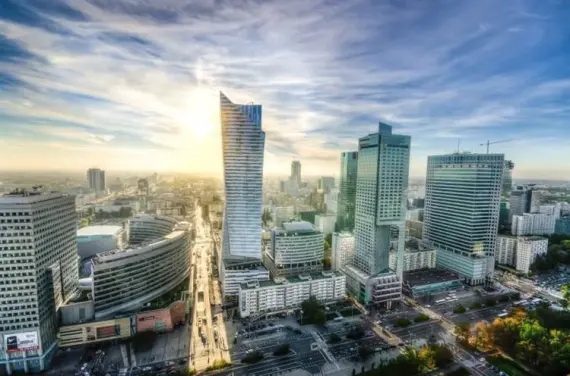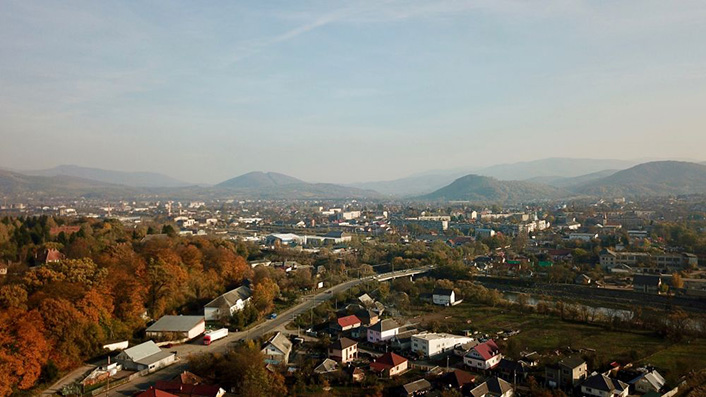Bus from WARSAW to SVALYAVA - find a connection and buy a ticket
WARSAW

Warsaw, the capital of Poland and the Mazovian Voivodeship, is the largest city in the country. It is located in the central part of it on the Central Mazovian Plain. It is one of the most rapidly developing cities in Europe and a great place to visit - both in winter and summer.
Warsaw is a remarkable city where history and historic sites mix with modern architecture. Visiting the city, you can both learn about the history of kings, hear about the heroic struggle of Poles during World War II, and relax and have fun. At the Copernicus Science Center you can experiment, at the Warsaw Zoo you can feel like a child, at the POLIN Museum of Polish Jews you can learn more about the extraordinary Jewish culture, and in Praga you can soak up the alternative atmosphere of this extraordinary city. Warsaw is also home to many beautiful parks and green spaces. In addition, as the only capital in Europe, the city lies in close proximity to a national park.
Warsaw - bus, train or how best to get to the capital?
You can get to Warsaw by car, using the highways, including A1, A2 or the expressways S7, S8 or S2. You can also fly - the city has two airports : Okęcie (otherwise known as Chopin Airport) and Modlin. You can also get to Warsaw by train or bus. The main and largest train station in Warsaw is the Central Railway Station located in the city center near the Palace of Culture and Science, although there are several other train stations available. The Sindbad stop is located at the PKS Zachodni Station, which serves domestic and international bus routes. If you are planning to visit the capital, take advantage of the connections we offer to and from Warsaw. You can find their full list and schedule on our website.
Warsaw, the capital of Poland and the Mazovian Voivodeship, is the largest city in the country. It is located in the central part of it on the Central Mazovian Plain. It is one of the most rapidly developing cities in Europe and a great place to visit - both in winter and summer.
Warsaw is a remarkable city where history and historic sites mix with modern architecture. Visiting the city, you can both learn about the history of kings, hear about the heroic struggle of Poles during World War II, and relax and have fun. At the Copernicus Science Center you can experiment, at the Warsaw Zoo you can feel like a child, at the POLIN Museum of Polish Jews you can learn more about the extraordinary Jewish culture, and in Praga you can soak up the alternative atmosphere of this extraordinary city. Warsaw is also home to many beautiful parks and green spaces. In addition, as the only capital in Europe, the city lies in close proximity to a national park.
Warsaw - bus, train or how best to get to the capital?
You can get to Warsaw by car, using the highways, including A1, A2 or the expressways S7, S8 or S2. You can also fly - the city has two airports : Okęcie (otherwise known as Chopin Airport) and Modlin. You can also get to Warsaw by train or bus. The main and largest train station in Warsaw is the Central Railway Station located in the city center near the Palace of Culture and Science, although there are several other train stations available. The Sindbad stop is located at the PKS Zachodni Station, which serves domestic and international bus routes. If you are planning to visit the capital, take advantage of the connections we offer to and from Warsaw. You can find their full list and schedule on our website.
SVALYAVA

Svalava (ukr. Свалява), a city in western Ukraine, Transcarpathian region, located in the valley of the Latoritsa River. It is a small city with a rich history and a unique location that makes it an important center in the Transcarpathian region.
Svalava's economy is based mainly on agriculture and tourism. The city lies in the picturesque region of Transcarpathia, which attracts tourists, especially those interested in mountain and ecological tourism. The region is home to numerous vineyards, as well as animal husbandry, especially cattle and sheep.
Svalava is also home to a thriving food industry, handicrafts and small-scale manufacturing. Although the city is not one of Ukraine's major industrial centers, it is an important point on the economic map of the Transcarpathian region.
Svalava is located in the northeastern part of the Transcarpathian region, about 50 kilometers southwest of Uzhhorod, the region's capital. The city is well connected to major centers in the region, and its proximity to the borders with Hungary and Slovakia makes Svalava an important point on the cross-border map of Ukraine.
The city is a place where different cultures meet, including Ukrainian, Hungarian and Slovakian, which influences local traditions and daily life. Svalava residents cherish their cultural heritage, organizing festivals, exhibitions and other events that attract tourists.
The region is also home to a number of religious buildings, which testify to the multicultural character of Transcarpathia. There are also local fairs and markets in and around Svalava, where handicrafts and traditional products can be found.
Svalava (ukr. Свалява), a city in western Ukraine, Transcarpathian region, located in the valley of the Latoritsa River. It is a small city with a rich history and a unique location that makes it an important center in the Transcarpathian region.
Svalava's economy is based mainly on agriculture and tourism. The city lies in the picturesque region of Transcarpathia, which attracts tourists, especially those interested in mountain and ecological tourism. The region is home to numerous vineyards, as well as animal husbandry, especially cattle and sheep.
Svalava is also home to a thriving food industry, handicrafts and small-scale manufacturing. Although the city is not one of Ukraine's major industrial centers, it is an important point on the economic map of the Transcarpathian region.
Svalava is located in the northeastern part of the Transcarpathian region, about 50 kilometers southwest of Uzhhorod, the region's capital. The city is well connected to major centers in the region, and its proximity to the borders with Hungary and Slovakia makes Svalava an important point on the cross-border map of Ukraine.
The city is a place where different cultures meet, including Ukrainian, Hungarian and Slovakian, which influences local traditions and daily life. Svalava residents cherish their cultural heritage, organizing festivals, exhibitions and other events that attract tourists.
The region is also home to a number of religious buildings, which testify to the multicultural character of Transcarpathia. There are also local fairs and markets in and around Svalava, where handicrafts and traditional products can be found.
© 2025 Sindbad
Technical support, assistance, payments: Sindbad IT
© 2025 Sindbad
Technical support, assistance, payments: Sindbad IT
